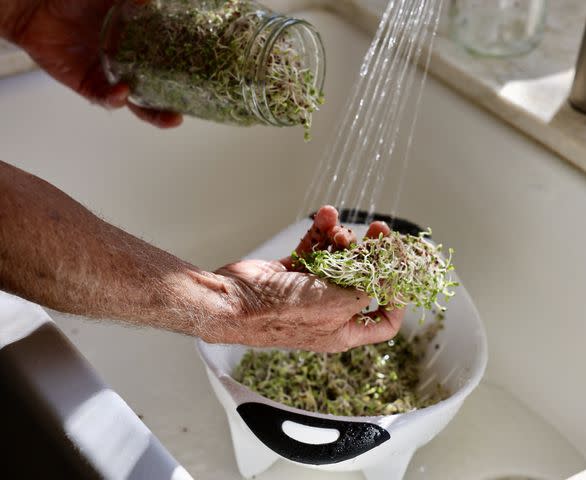Broccoli Sprouts: What Makes Germinated Broccoli So Nutritious?
Medically reviewed by Jonathan Purtell, RDN
Broccoli sprouts are nutritious plant shoots that look like alfalfa sprouts.The same broccoli seeds (Brassica oleracea var. italica) that mature into crowns are used to grow broccoli sprouts, which taste like radishes.
Full-grown broccoli florets aren't harvested for two to months, and baby broccoli sprouts can be eaten a few days after the seeds germinate. Young germinated broccoli contains 10–100 times more sulforaphane than mature broccoli plants.
This article explains how to sprout broccoli seeds at home, gives the facts about broccoli sprouts' nutrition, discusses the benefits of eating more broccoli sprouts, and highlights some special precautions regarding broccoli sprouts' sulforaphane levels.
E. Coli and Salmonella Risk
Most store-bought sprouts are screened for Escherichia coli (E. coli) and Salmonella. Nonetheless, because sprouts aren't usually cooked, always be cautious about pathogens (germs). Rinsing seeds two or three times daily (every eight to 12 hours) while germinating in a jar lowers the risk of unhealthy bacterial growth.

Heidi Patricola / Getty Images
Broccoli Sprouts: How Do They Grow?
Growing nutritious broccoli sprouts at home facilitates eating freshly germinated seeds in their prime and lowers the risk of foodborne illness. If you're considering buying broccoli seeds for sprouting, read on to learn why it's a worthwhile health investment and an easy DIY project.
To grow broccoli sprouts at home, you'll need the following:
Broccoli sprouting seeds (Brassica oleracea Italica group)
Mason jars
Cheesecloth or screened straining lids
Broccoli sprouts are grown indoors, away from direct sunlight, using a sterilized Mason jar; they don't require soil. Start by putting about two tablespoons of broccoli seeds in a jar, covering the seeds with water, and soaking them overnight in the dark.
The next morning, strain the seeds using cheesecloth or a screened lid and roll the jars sideways to break up clumps. Then, place them upside down at a 45-degree angle on a drip tray in a dark place or someplace that only gets indirect daylight.
Over the next few days, the sprouting broccoli seeds should be thoroughly rinsed with cool water twice daily, drained, rolled around repeatedly to break up clumps, and placed upside down at an angle to continue draining. Twice-daily washing and rinsing cycles are necessary to prevent broccoli sprouts from growing mold spores during germination. Do three daily rinses if you're in a hot/humid climate and during the summer.
Near the end of day three, taste a small pinch of budding sprouts–which should almost fill the entire jar by now—to see if they're ready to harvest. Broccoli sprouts are usually in their harvesting prime between three and five days and past their prime after six days in a germinating jar.
Once the broccoli sprouts are ready to harvest, shake them out of the jar, submerge the green shoots in a bowl of cool water, and gently stir to loosen the hulls. Use a kitchen strainer to skim hulls from the water's surface and place the hull-less sprouts on a paper towel to dry.
Broccoli sprouts' benefits are most robust just after harvesting. Eat promptly or refrigerate and enjoy home-grown broccoli sprouts soon thereafter; they'll last about five to seven days in the fridge.
Food Safety
Before touching broccoli seeds, wash your hands and wear sanitary food-handling gloves. When preparing seeds for sprouting in the kitchen area, make sure they don't come in contact with germs that cause food poisoning. Just like you'd sterilize canning jars before preserving food, sterilizing the tools you use to grow germinated broccoli sprouts at home is always a good idea.
Nutrition Facts: 1 Serving of Broccoli Sprouts
A one-half cup serving of broccoli sprouts weighing 28 grams (g) contains:
Energy (calories): 10.1 calories
Protein: 1 g
Carbohydrate: 1 g
Total lipid (fat): 0 g
Fiber: 1.01 g
Calcium: 30 milligrams (mg)
Iron: 4 mg
Sodium: 0 mg
Cholesterol: 0 mg
In addition to micronutrients like calcium and iron, broccoli sprouts also contain trace amounts of vitamin A and a relatively high amount of vitamin C.
Extremely high sulforaphane content sets broccoli sprouts apart from other cruciferous vegetables, including broccoli florets from the same seeds. Young broccoli sprouts contain up to 100 times the amount of sulforaphane in mature crowns.
What Is Sulforaphane?
Sulforaphane is a plant-based isothiocyanate compound derived from glucosinate glucoraphanin found in cruciferous vegetables like broccoli, cauliflower, Brussels sprouts, and kale. Broccoli sprouts have more glucoraphanin (which turns into sulforaphane) than other cruciferous vegetables in the Brassicaceae family.
Benefits of Eating More Broccoli Sprouts
Broccoli sprouts are considered a superfood. They contain an extraordinarily high amount of glucoraphanin, which turns into the antioxidant phytochemical sulforaphane inside your body.
The benefits of eating broccoli sprouts rich in sulforaphane may include:
Antioxidant properties (protection against free radicals)
Anti-inflammatory action (decreases IL-6 levels)
Heart disease protection
Gut microbiome betterment
Reduced inflammatory bowel disease (IBD) symptoms
Special Precautions With Sulforaphane
People taking certain medications should be cautious about consuming large doses of foods like broccoli sprouts that contain a lot of sulforaphane. Some research suggests that ingesting less than 100 milligrams per kilogram of body weight (mg/kg) of sulforaphane interferes with antiepileptic drugs like Tegretol (carbamazepine).
How to Enjoy Broccoli Sprouts
Raw broccoli sprouts can be added to salads, put in sandwiches, used as soup garnish, or blended into smoothies. Cooked broccoli sprouts can be steamed, sautéed, or mixed into a stir-fry.
Summary
Broccoli sprouts are freshly germinated broccoli seeds that can be homegrown in three to five days or purchased at a store. Broccoli sprouts are a nutritious superfood packed with sulforaphane, an antioxidant that may lower cancer risk, reduce inflammation, and have other health benefits. Avoid broccoli sprouts that are moldy or contaminated with bacteria that can make you sick.
Read the original article on Verywell Health.
